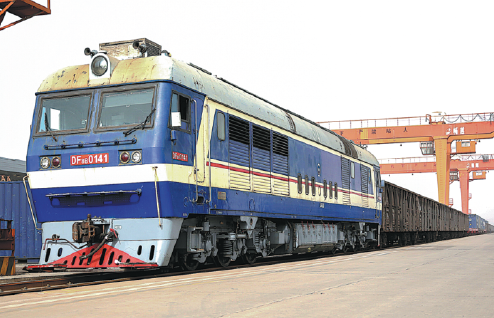Transformed industrial sector opens up more trade avenues abroad
Updated: 2022-04-01

A train loaded with 50 sets of advanced power generators produced in Shanxi province leaves the city of Houma for the Southeast Asian country of Laos on March 15. [Photo by Guo Yanjie for China Daily]
Fostering advanced manufacturing in Shanxi leads to province selling cutting-edge power equipment to Laos, delivered via new railway line
A cargo train loaded with 50 sets of advanced power generators produced in Shanxi province left the city of Houma for the Southeast Asian country of Laos on March 15.
The train, traveling through Xi'an in Shaanxi province and the Mohan Land Port in Yunnan province, arrived in Vientiane, capital of Laos, via the newly built China-Laos Railway.
It was the first time that Shanxi-made advanced equipment had been delivered to Southeast Asia via the railway, a milestone in the province's opening-up.
Shanxi, which has positioned itself as a new hub for opening-up in inland China, has developed the China-Europe freight train service since 2017. The Zhongding Logistics Park in the city of Jinzhong is the starting point of this major trade route.
A bonded land port logistics park became operational recently in Houma. It is designed as a hub for foreign trade business with Southeast Asia.
Lu Yong, general manager of the Taiyuan Bureau of China Railway Group, the operator of the freight train service, said his company will move more cargo to Southeast Asian countries including Laos, Thailand, Cambodia and Vietnam on the new railway line in the near future.
By shipping locally made advanced equipment overseas, local officials said the freight train service showcases Shanxi's achievements in industrial transformation.
Shanxi has transformed its industrial sector in recent years with an initiative that fosters emerging sectors like advanced manufacturing and upgrades traditional sectors like coal mining.
One example of Shanxi's advanced manufacturing is Lu'an Solar Power Technologies based in the city of Changzhi.
The company uses the latest technologies, including robots, to produce a new generation of photovoltaic cells.
Shen Fangtao, an executive of the company, said Lu'an now ranks fifth globally in the sales volume of photovoltaic cells. This is echoed by a recent report released by China's authoritative solar power research and consultancy institution, PV InfoLink.
"To meet the strong demand from clients in more than 30 countries and regions, all the six production lines of our company are now running at full capacity," Shen said. "Our current output is about 720,000 cells a day."
The executive said Lu'an is installing another two production lines to meet increasing demand.
In addition, the company has focused on the research and development of high-efficiency photovoltaic cells.
"A recent breakthrough is that we have developed a large-sized cell, which can improve power generation capacity by 10 percent," Shen said.
He explained such an improvement is the result of the use of aluminum oxide purification technology to avoid electricity loss caused by higher-resistance components.
Shanxi is a province rich in bauxite, a mineral used for producing aluminum oxide and other aluminum products. Local enterprises are now focusing on developing higher value-added products from aluminum oxide, especially those used in the electronics, semiconductor and energy industries.
Huajing Hengji New Materials based in the city of Xinzhou is now using the rich local bauxite resources to produce patterned sapphire substrate.
Patterned sapphire substrate, or PSS, is a kind of artificial sapphire made from aluminum oxide.
"The artificial sapphire is not used for jewelry," said Kuang Guangning, general manager of the company. "PSS is widely used in the semiconductor, LED display and lighting industries for its high degree of transparency."
The company's major products include a 4-inch round PSS chip inscribed with 850 million pyramid-shaped patterns designed for LED displays, according to Kuang. He added that Huajing Hengji is one of only a few Chinese providers of PSS chips with a diameter of less than 6 in.
"The 4-in chip can be further divided into small pieces and used in more than 87,000 types of LED display devices," Kuang said.
The company was founded in 2019 and began mass production in September 2020. Its sales revenue surpassed 200 million yuan ($31.53 million) in the first year of operation, according to Kuang. He added that its 2021 sales revenue doubled the figure of 2020.
While Lu'an and Huajing Hengji represent the rapid development of cutting-edge emerging sectors, coal-mining and energy giant Jinneng Holding Group is an example of how traditional industries are being upgraded with technology.
The group's Tashan Coal Mine is among the pioneering smart coal mines in Shanxi, using digital and 5G-connected technologies.
The coal mine is constantly upgrading its equipment and technologies to digitalize its operations, according to its executive Li Hua.
These upgrades include the use of robots for coal mine shaft patrols and inspection, fully automated coal cutting and conveyance, and 5G-connected monitoring, according to Li.
Niu Fulong, an executive of Jinneng Holding, said the group will have another six coal mines "going smart" this year.
Guo Yanjie contributed to this story.



